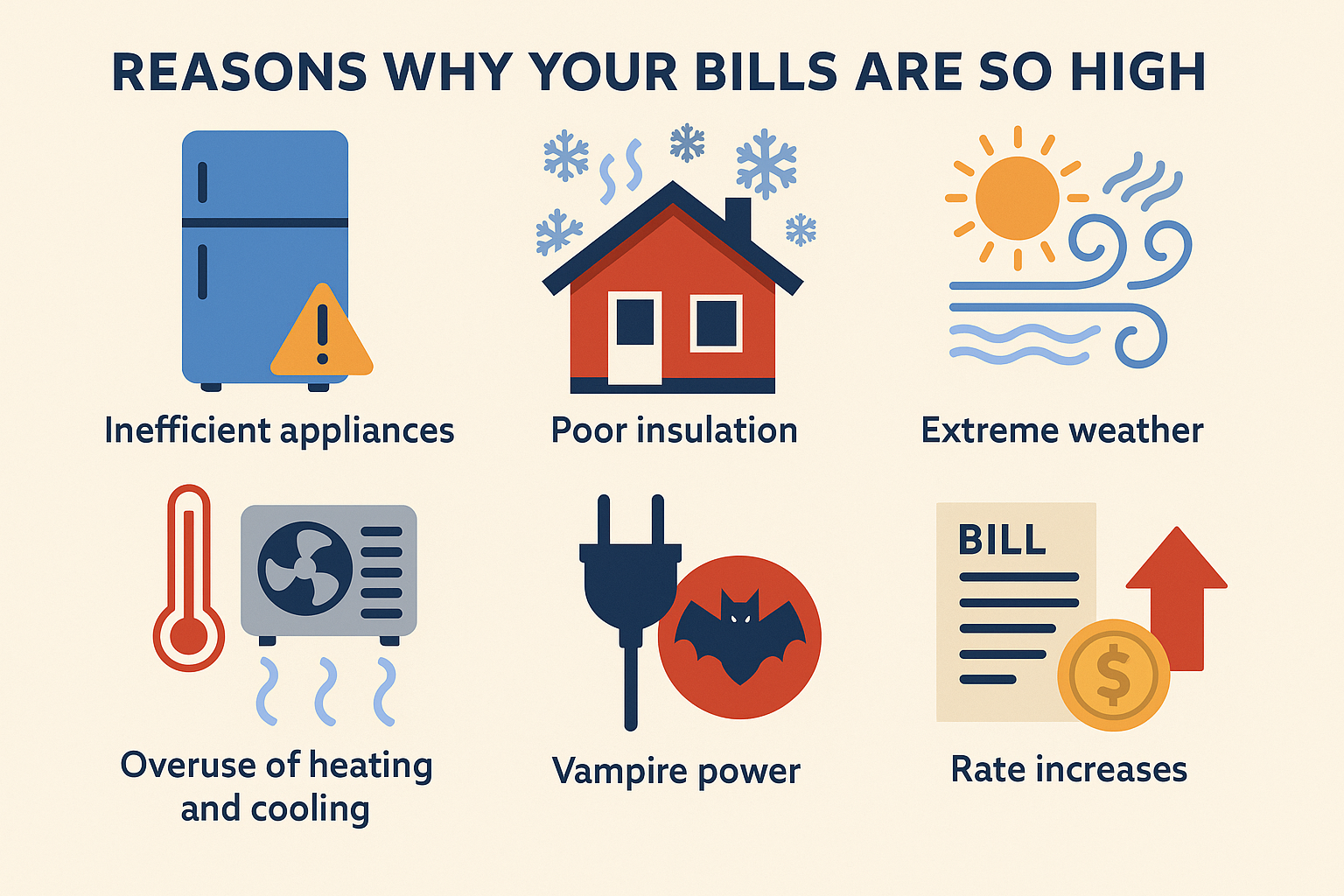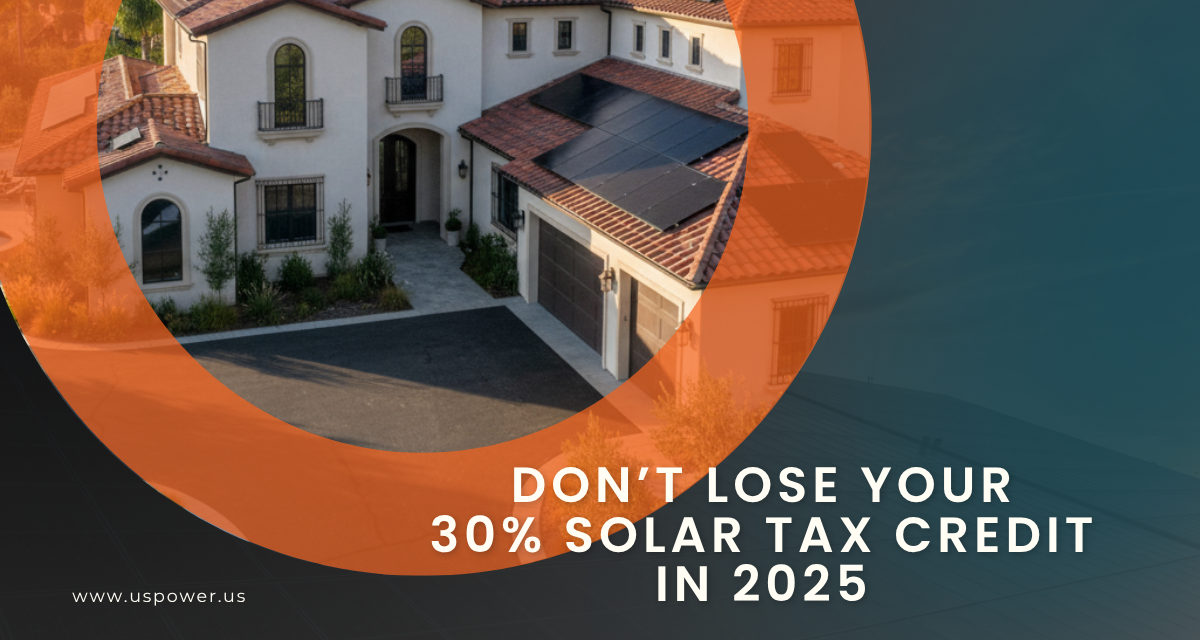Electricity Bills Soaring? See Which States Are Paying the Most

Solar and Roofing Advisor
Discover why electricity rates are spiking nationwide, where California stands, and how SoCal homeowners can save with QCells solar from US Power.

As of July 2025, the average household price of electricity in the United States has increased by 9.5 percent so far this year, according to the Energy Information Administration (EIA). You might assume that the sharpest spikes occurred in states already known for high electricity costs—such as California—or those within the PJM Interconnection, a multistate grid currently under scrutiny for its rising prices.
However, some of the most dramatic rate hikes have appeared in less-expected regions.
Missouri tops the list with a 38.3 percent jump, followed by North Dakota at 33.6 percent, New Jersey at 28.6 percent, Iowa at 27.5 percent, and Montana at 25.3 percent.
Meanwhile, California ranks 12th, with a 7.8 percent year-to-date increase—below the national average but still significant given that the state already has some of the highest baseline electricity rates in the country.
The 2025 Electricity Surge: A Snapshot of the Top States
Electricity rates are rising across nearly every state, but the reasons vary widely. While Missouri and North Dakota have seen the sharpest percentage spikes, California, New Jersey, and Maryland continue to hold some of the highest per-kilowatt-hour costs nationwide. The 2025 surge reveals how unpredictable the U.S. power landscape has become—where both fossil fuel-dependent and clean energy–focused states are struggling to keep prices stable.
For example, Missouri’s record 38.3% increase stems from major infrastructure overhauls and multiple utility rate approvals. North Dakota’s 33.6% hike reflects pressure from rising natural gas costs and transmission expansion. New Jersey, part of the PJM Interconnection, faces higher wholesale prices driven by regional grid congestion. Even states with growing renewable portfolios, like Iowa and Montana, are seeing upward pressure due to grid modernization and maintenance expenses.
In short, the issue isn’t limited to one part of the map—electricity prices are climbing everywhere, and households are feeling the squeeze.
Updated List (Including California’s Rank)
According to the analysis of EIA data, these states have recorded the steepest electricity rate hikes in 2025 (January–July):
| Rank | Missouri | Rate Increase (2025 YTD) | Notable Context |
|---|---|---|---|
| 1 | Missouri | +38.3% | Driven by multiple utility rate approvals and infrastructure upgrade costs. |
| 2 | North Dakota | +33.6% | Rapid utility cost recovery amid fuel price volatility. |
| 3 | New Jersey | +28.6% | PJM-related rate pressures and regulatory adjustments. |
| 4 | Iowa | +27.5% | Utility modernization and grid reliability investments contributing to higher bills. |
| 5 | Montana | +25.3% | Transmission expansion and rural service costs pushing rates upward. |
| 12 | California | +7.8% | Despite modest year-over-year growth, California remains among the states with the highest baseline electricity costs nationwide due to wildfire prevention spending, grid maintenance, and clean energy transitions. |
Why Are Electricity Prices Rising So Fast?
Several interconnected factors are driving up power costs across the U.S. in 2025. Understanding these causes helps explain why the problem isn’t temporary—and why more Americans are turning to solar energy as a long-term shield against inflation.
1. Soaring Energy Demand from AI, EVs, and Data Centers
The rapid expansion of AI computing, electric vehicles, and data centers has created record-breaking energy demand. These high-consumption facilities require immense power 24/7, forcing utilities to expand generation capacity and upgrade grid infrastructure—costs that get passed on to everyday consumers.
2. Delayed Grid Upgrades and Interconnection Bottlenecks
While clean energy adoption is rising, many projects are stuck in interconnection queues, unable to connect to the grid quickly enough to meet growing demand. This limits power supply flexibility, pushing utilities to rely on older, more expensive generation sources.
3. Fuel Price Volatility and Legacy Dependence
States heavily reliant on natural gas or coal remain vulnerable to global fuel market swings. Even short-term spikes in gas prices can cascade into long-term rate hikes for consumers, especially in the Midwest and South.
4. Transmission and Wildfire-Resilience Costs
In states like California, significant investment is going into wildfire mitigation, undergrounding power lines, and hardening transmission networks. These costs, though necessary for safety, contribute to higher electricity bills.
5. Regulatory Policies and Utility Rate Structures
Each state regulates electricity differently. Some states, like Texas, have deregulated markets that fluctuate with wholesale prices, while others, like California, rely on investor-owned utilities that must seek rate approvals from public commissions. These differences create varying degrees of consumer protection—or exposure—to rising costs.
How California Compares in 2025
Even though California ranks 12th in year-to-date electricity rate increases, the state’s baseline rates are already among the highest in the nation. Customers served by Southern California Edison (SCE), San Diego Gas & Electric (SDG&E), and Los Angeles Department of Water and Power (LADWP) are paying some of the most expensive electricity rates in the U.S.
Several factors explain why California remains near the top:
- Wildfire mitigation and grid safety investments drive significant infrastructure costs.
- Clean energy transition goals (100% renewable by 2045) require capital-intensive projects.
- Aging infrastructure and extreme weather events accelerate maintenance needs.
As a result, even modest increases—like the current 7.8% rise—can translate to hundreds of dollars per year in added household costs.
The Solar Solution: Why Homeowners Are Taking Control
With electricity prices climbing faster than inflation, homeowners across Southern California are looking for ways to stabilize or even eliminate their utility bills. That’s where solar energy has become the game-changer.

By switching to solar, you’re not just producing your own electricity—you’re locking in predictable energy costs for decades, shielding your home from future rate hikes. Under California’s NEM 3.0 policy, homeowners can still earn credits for excess energy sent to the grid, while battery storage systems help maximize self-consumption and reduce reliance on utilities.
And with US Power’s exclusive partnership with QCells, customers gain access to factory-direct pricing on American-made solar panels—offering top-tier performance, long-term reliability, and powerful ROI. QCells’ advanced technology ensures you generate more clean energy with fewer panels, which is ideal for urban rooftops across Los Angeles, Ventura, and Orange County.
What Rising Electricity Prices Mean for Southern California Homeowners
Even if California’s rate increase isn’t as steep as in other states, the total cost per kilowatt-hour remains among the highest in the country. For residents served by SCE, SDG&E, or LADWP, this means:
- Electricity bills keep climbing despite using less energy.
- Time-of-use rates are penalizing high-demand hours, especially for EV owners.
- Solar savings are now greater than ever, with 20-year lifetime savings averaging $40,000–$60,000 for typical homes.
By going solar now—before additional utility rate cases or NEM adjustments—homeowners can maximize their savings potential and lock in a predictable energy future.
Take Control Before the Next Rate Hike
Every month you delay switching to solar, you’re effectively paying a higher “energy tax” to your utility. Instead of waiting for the next rate increase, take control of your energy future today.
✅ Schedule your free, no-obligation solar consultation with US Power.
✅ See your real 25-year savings projection using today’s rate forecasts.
✅ Enjoy factory-direct QCells pricing and maximize your return on investment.
US Power makes going solar simple, affordable, and local—serving homeowners across Southern California with personalized, high-efficiency solar solutions built to outlast rising utility rates.
Schedule an appointment today to find out how much you could save before the next electricity hike hits your area.
Related Articles
Our Related Blogs
Get smart and go solar safely—avoid hidden costs with US Power’s expert guidance.
Stay compliant and protect your solar tax credit with reliable solar consultants.
Combat rising electricity costs with smart home solar solutions from US Power.
Our Solar and Roof Brand Partners








We empower communities and businesses to harness clean, renewable solar energy solutions that drive sustainable growth.
Ready to Own Your Power? Call us today!
818-650-8010
Copyright © 2025 US Power - Axia by QCells. All Rights Reserved.
Privacy is important to us, so you have the option of disabling certain types of storage that may not be necessary for the basic functioning of the website. Blocking categories may impact your experience on the website.
Essential
These items are required to enable basic website functionality.
Personalization
These items allow the website to remember choices you make (such as your user name, language, or the region you are in) and provide enhanced, more personal features.
Marketing
These items are used to deliver advertising that is more relevant to you and your interests.
Analytics
These items help the website operator understand how its website performs, how visitors interact with the site, and whether there may be technical issues.
We and our third-party partners use cookies and other technologies to enhance and track your experience on this site, conduct analytics, and personalize marketing to you. By using the site, you agree to our use of these technologies, including recording and monitoring your interactions with the site.
Get an instant solar estimate using satellite!









